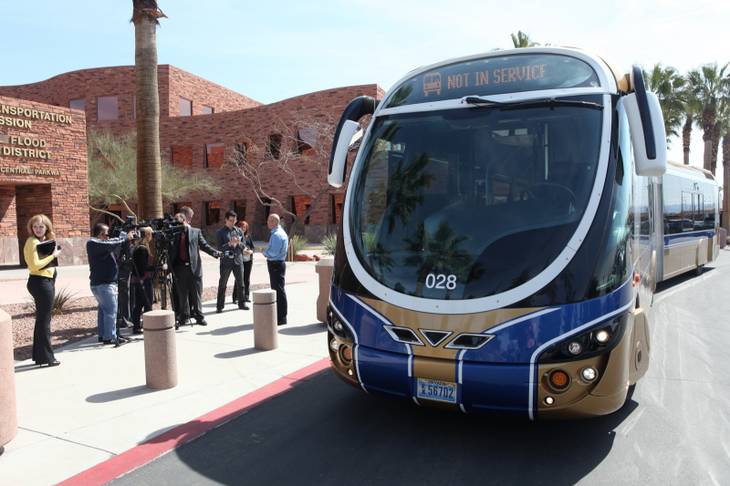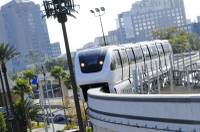Members of the Regional Transportation Commission of Southern Nevada say it’s time to begin planning an intermodal transit center in Las Vegas to connect bus, train and monorail passengers at one location.
Commissioners went into long-term planning mode after hearing a series of reports from key leaders from the Nevada Department of Transportation, Las Vegas Monorail Co., XpressWest high-speed rail project and Western High Speed Rail Alliance.
“It’s time to start thinking big,” said Commissioner Steve Ross, a member of the Las Vegas City Council. “I don’t know what you’d call it. Union Station? Las Vegas Station?”
Whatever it’s called, commissioners acknowledged that a well-planned and designed system is key to connecting passengers arriving on different modes of transportation. Commissioners also conceded that they need to do a better job of taking advantage of existing transportation assets. One example: a rarely used rail spur that extends from near the resort corridor through Henderson.
Commissioners heard three hours of status reports at Thursday’s meeting.
NDOT engineer Sondra Rosenberg briefed commissioners on the Interstate 15 Corridor System Master Plan from San Diego to the Utah-Idaho border. The I-15 Mobility Alliance was formed so that California, Nevada, Arizona and Utah could work together to develop improvement projects for Las Vegas’ most important highway.
The alliance, a 72-member organization working to prioritize efforts on the highway, is not only focused on moving passenger traffic in cars but with the transport of goods from California ports north to Las Vegas and Utah. Rosenberg said the group is considering adding members in Idaho and Montana to cover areas north to the Canadian border.
Rosenberg also touched on the proposed Interstate 11 project, the effort to upgrade U.S. 93 to interstate highway standards between Phoenix and Las Vegas. The I-11 corridor was recently designated in transportation legislation, and planning is in preliminary stages.
Commissioners also eceived updates about two transportation systems with similar problems — a lack of money.
XpressWest, a high-speed rail project between Las Vegas and Southern California, has a favorable outlook, said Andrew Mack, chief operating officer of the private company that is planning the 185-mile, double-track project between Las Vegas and Victorville, Calif.
Mack said the system has all environmental approvals and land-use certifications for the rail line that would be built along I-15. All the company is waiting for is approval of a $5.5 billion Railroad Rehabilitation and Improvement Financing loan from the Federal Railroad Administration.
Mack told commissioners that XpressWest has identified two potential station locations in Las Vegas, both just west of I-15. One site is near Flamingo Road, near the Rio, and the other is near Russell Road, across the highway from Mandalay Bay.
Mack’s identification of those station sites was what got commissioners starting to think about an intermodal station.
The Las Vegas Monorail update was one of the first public comments about the 3.9-mile system since the U.S. Bankruptcy Court approved its reorganization plan in May.
The plan enabled the company to reduce its debt load from $757 million to $13 million — an annual payment of roughly $640,000 a year.
The reduced debt payment enables the system to continue to operate without tax subsidies and allow the company to prepare for overhauls for new fare collection systems in 2020, new train control systems in 2024, new trains in 2034 and new communications systems in 2035.
Curtis Myles, the CEO of the Las Vegas Monorail, said that while the system helps reduce 35 tons of greenhouse gas emissions in a year by saving 22,334 taxi trips or 1,218 bus shuttle trips to conventions, the system still doesn’t have the means to expand the line to McCarran International Airport or downtown Las Vegas.
Transportation consultant Tom Skancke, who heads the Western High Speed Rail Alliance, applauded the commission for beginning the discussion on a centralized station to serve the various transportation modes.
The alliance, composed of planning agencies in four states, envisions a high-speed rail network in the West, connecting Las Vegas with Salt Lake City, Denver and Phoenix.


